Places of Interest in Phnom Penh
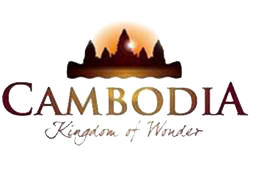 |
|
|
|
Wat Phnom (Wat Phnom Daun Penh) - Phnom Penh (Capital)
Wat Phnom, the namesake and symbol of the capital city of Phnom Penh, sets prominently atop an artificial 27 meter hill (or 'Phnom') in the northeastern section of the city. Legend has it that Daun Penh, a wealthy widow, retrieved a large koki tree trunk from the river. She had hoped to use it for a house, but inside a hollow of the trunk, she found four statues of the Buddha. She then ordered for a section of her property to be elevated for a small shrine to be erected to revere the statues. This became a sacred site and people started to settle around the hill; eventually, this became the city it now is. It is here that the city gets its name: ‘Phnom’ means hill in Khmer and ‘Penh’ is of course the name of the lady.
Royal Palace
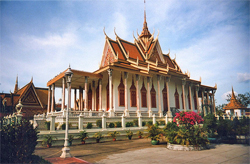 The Royal Palace of
Cambodia is a complex of buildings, even though it
is generally understood to be the royal abode of the
King of Cambodia. The compound was the citadel of
King Ponhea Yat (1393-1463) and rebuilt to its
present state in 1886, when King Norodom (1834-1904)
relocated the royal capital from Oudong to Phnom
Penh. The buildings with beautiful towering spires
are a great example of classic Khmer architecture
found in Cambodia today.
The Royal Palace of
Cambodia is a complex of buildings, even though it
is generally understood to be the royal abode of the
King of Cambodia. The compound was the citadel of
King Ponhea Yat (1393-1463) and rebuilt to its
present state in 1886, when King Norodom (1834-1904)
relocated the royal capital from Oudong to Phnom
Penh. The buildings with beautiful towering spires
are a great example of classic Khmer architecture
found in Cambodia today.
Along with numerous other interesting buildings, within the 183,135 square meters (421m x 435m) compound is The Khemarin Palace, also known as Prasat Khemarin or the "Palace of the Khmer King." This is officially the residence of His Majesty, King Norodom Sihamoni.
Silver Pagoda
The Silver Pagoda, also known as the Preah Vihear Preah Keo Morokat (the Emerald Pagoda) to Cambodians, lies within the grounds of the Royal Palace, which is situated near the banks of the Mighty Mekong.
Originally a wooden structure, the palace was initially constructed in 1892 during the reign of King Norodom, but rebuilt to its present grandeur by King Norodom Sihanouk in 1962. The king spared no effort to make this a true embodiment of brilliant Khmer art. More than 5300 pcs of 1.125 kilo silver tiles are used to cover the floor of the Silver Pagoda, and the silver pieces collectively weigh over six tons.
National Museum
The National Museum of Cambodia in Phnom Penh is the country’s leading historical and archaeological museum. It was officially inaugurated by King Sisowat in 1920.
Independence Monument (Vimean Ekareach)
Built in 1958 as a memorial to Cambodia's war dead and to celebrate independence from foreign rule, the monument stands majestically on the intersection of Norodom Boulevard and Sihanouk Boulevard in the centre of the city. It is designed by the influential Cambodian modern architect Vann Molyvann in the form of a lotus-shaped stupa in the same style seen at the great Khmer temple at Angkor Wat and other Khmer historical sites.
Phsar Thmey (Central Market)
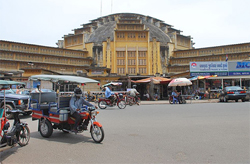 Phsar Thmey, also
known as Central Market, is a unique colonial style
building constructed in 1937. The location where the
Central Market now sits was once a swamp area and
occupied by a lake known as Beng Decho. Today, this
beautiful market has become a prominent landmark in
Phnom Penh. In the Khmer language, Phsar Thmey
literally means ‘New Market’.
Phsar Thmey, also
known as Central Market, is a unique colonial style
building constructed in 1937. The location where the
Central Market now sits was once a swamp area and
occupied by a lake known as Beng Decho. Today, this
beautiful market has become a prominent landmark in
Phnom Penh. In the Khmer language, Phsar Thmey
literally means ‘New Market’.
Phsar Toul Tum Poung (Russian Market)
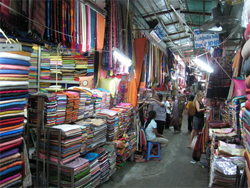 Toul Tum
Poung market is often referred to as the
Russian market because of its popularity
among Russian expatriates during the
1980s. This market is popular to
collectors of genuine antiques; also for
those looking for good reproductions.
Toul Tum
Poung market is often referred to as the
Russian market because of its popularity
among Russian expatriates during the
1980s. This market is popular to
collectors of genuine antiques; also for
those looking for good reproductions.
Night Market
No shopping experience is complete without the thrills and satisfaction of shopping at night--especially one as a tourist in an exotic destination.
The night market in Phnom Penh, located in front of the Phsar Chas (Old Market) near the riverside, is perpetually crowded with tourists in search of a good bargain. At the moment, there are more than 150 stalls selling an array of items from clothing and ornaments to furniture and souvenirs. The entire setting of the Phnom Penh night market is made from natural material, and there are occasionally music performances and entertainment acts.
Riverfront
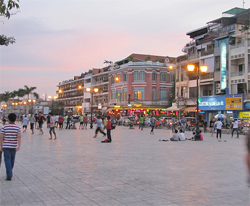 The
riverfront offers some of the city’s
most interesting sites including dozens
of pubs, galleries, cafés, restaurants
and shops that sit along one side of
Sisowath Quay overlooking the Chaktomuk
(the confluence of the Tonle Sap, Mekong
and Bassac Rivers).
The
riverfront offers some of the city’s
most interesting sites including dozens
of pubs, galleries, cafés, restaurants
and shops that sit along one side of
Sisowath Quay overlooking the Chaktomuk
(the confluence of the Tonle Sap, Mekong
and Bassac Rivers).
The park-like riverside is a great place to absorb local flavours and watch the locals unwind and enjoy a late afternoon stroll on the esplanade. Early risers may wish to check out the spectacular sunrise over the river in front of the Royal Palace.
River Cruise
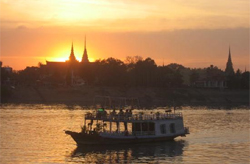 The
mighty Mekong River is indeed, in more
ways than one, the lifeline that runs
through the heart of southeast Asia.
Rising from the Himalayan mountain of
Tibet, it trickles and gradually winds
its way through China, Myanmar,
Thailand, Laos, Cambodia and Vietnam
before spilling into the South China
Sea. In its course, the mighty Mekong
meets the Tonle Sap Lake which is the
largest lake in South East Asia and
effectively, the heartbeat of Cambodia.
The annual pulsation of the flooding
seasons has been a huge contribution to
Cambodia’s existence for millenniums.
The
mighty Mekong River is indeed, in more
ways than one, the lifeline that runs
through the heart of southeast Asia.
Rising from the Himalayan mountain of
Tibet, it trickles and gradually winds
its way through China, Myanmar,
Thailand, Laos, Cambodia and Vietnam
before spilling into the South China
Sea. In its course, the mighty Mekong
meets the Tonle Sap Lake which is the
largest lake in South East Asia and
effectively, the heartbeat of Cambodia.
The annual pulsation of the flooding
seasons has been a huge contribution to
Cambodia’s existence for millenniums.
Toul Sleng Genocide Museum (S-21)
Prior to 1975, Toul Sleng was a high school. When the Khmer Rouge came to power it was converted into the S-21 prison and interrogation facility. Inmates were systematically tortured to extract confessions, after which they were executed at the killing fields of Choeung Ek. S-21 processed over 17,000 people, less than a dozen of whom survived. The building now serves as a museum, a memorial and a testament to the madness of the Khmer Rouge regime.
Choeung Ek Memorial (The Killing Fields)
Located about 17km south of Phnom Penh, Choeung Ek was once an orchard and a Chinese graveyard. It was used by the Khmer Rouge regime as an execution ground to put down thousands of people between 1975 and 1979. The site is now better known as the Killing Fields. Mass graves containing thousands of bodies were discovered at Choeung Ek after the fall of the Khmer Rouge regime. Many of the dead were former inmates in the Tuol Sleng prison.
Today, Choeung Ek is a memorial, marked by a Buddhist stupa. The stupa has acrylic glass sides and is filled with more than 5,000 human skulls; many of which are either shattered or had evidently been smashed. It is believed that the Khmer Rouge soldiers kill their victims by smashing them on the head, in order to save on bullets.
Ounalom Monastery
The origin of the Ounalom Pagoda can be traced to as far back as the 15th Century. It was built in 1422 by King Ponyea Yat, the last king of the Khmer empire. It is one of the five original monasteries in Phnom Penh that King Ponhea Yat had built.
Wat Ounalom is recognized as the ‘headquarters’ of Cambodian Buddhism. The patriarch, the chief abbot of Cambodia, resides here. The compound, forty four buildings in all, is about 250 metres north of the Royal Palace along Sisowath Quay at the river front. This monastery was home to over 500 monks and housed a huge library consisting of over 30,000 titles. During the regime of the Khmer Rouge, many of the buildings along with many religious statues and symbols were damaged, but most of which have since been restored. The buildings are used for a variety of purposes. There is the temple itself, schools, libraries, living quarters and the stupa that gives the temple its name; the stupa holds an Ounalum, a hair from the eyebrow of the Buddha.
Street 240
Street 240's tree shaded avenue harbors a unique collection of quality boutiques and souvenir shops, offering Cambodian silks and silk fashions, Southeast Asian art, handicrafts, curios andfurniture. There are a few restaurants, bars, wine shops, bookstores, and travel agencies interspersed along the way. After visiting the Royal Palace, stroll around the corner to explore Street 240. Most of the shops are concentrated along the couple of blocks between Street 19 and Norodom Blvd. At the corner of Street 240 next to the Royal Palace, the Council of Ministers building sits distinctively, particularly photogenic in the late afternoon. Before heading up 240, consider taking a short detour through the park to Wat Botum to see the towering white 'Buddha Relic Stupa'. As you are walking up Street 240 from the Palace area note the well preserved colonial era villas on the south side of the street.
Boeung Keng Kang 1 (BKK1)
Boeung Keng Kang 1 (BKK1), bordered by Sihanouk, Norodom, Mao Tse Toung, and Monivong Boulevards, has been considered the city's 'foreigner quarter' since the 80s. The area is the base for many NGOs, embassies, expatriate residences and hotels catering to long-term visitors. The whole of Boeung Keng Kang 1 is dotted with visitor-oriented businesses hotels, restaurants, bars, silk shops, massage spas, travel agents and realtors, with the greatest concentration of businesses at the northern end in the Street 278/282 area, particularly between Streets 51 and 63. Street 278 is lined with restaurants, bars, shops and small hotels frequented by an interesting mix of NGO and IO workers as well as tourists and expatriates. The Street 278 area is well worth a visit and a stroll anytime of day, but especially for lunch or dinner, or even better, in the early evening when the bars are cafés are full and the street is at its liveliest.
Street 178
Street 178 has long been known as 'Art Street' for the local sculpture shops and art galleries that line the road near the National Museum and Royal University of Fine Arts. Sculptors work on the street next to Wat Sarawan and the local galleries clustered near the Museum, most focusing on commercial and popular Cambodian art. But there are also a number of artists' galleries, handicraft and silk boutiques as well as a few restaurants and bars, especially close to the riverfront. The award winning Reyum Gallery is of particular note, which offers changing exhibitions of traditional and contemporary art by noted Cambodian artists. Toward the river end of 178 there are several restaurants and bars including the famous FCC.

